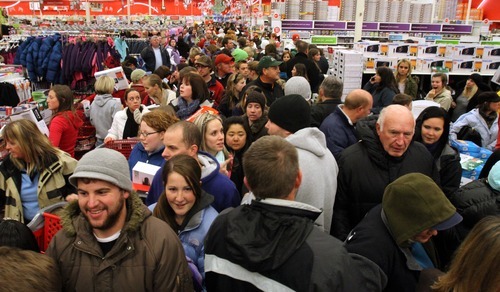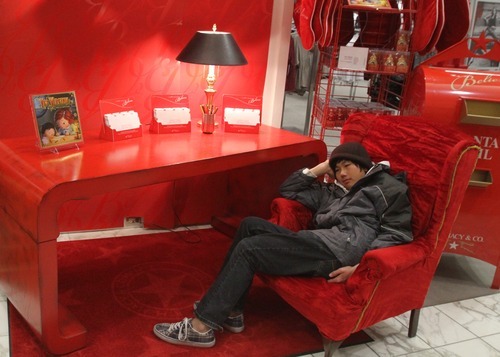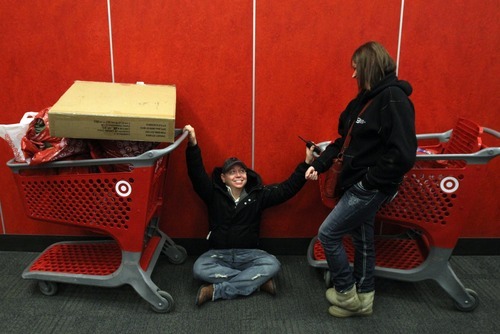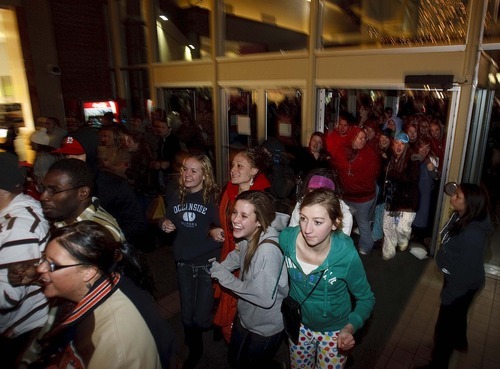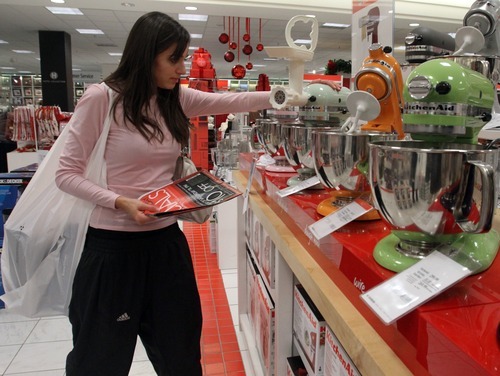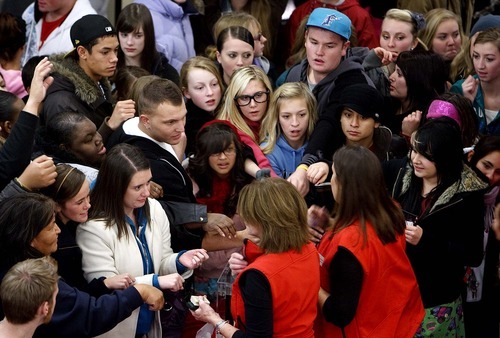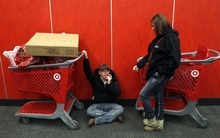This is an archived article that was published on sltrib.com in 2010, and information in the article may be outdated. It is provided only for personal research purposes and may not be reprinted.
Shoppers crowded stores along the Wasatch Front on Black Friday, scoring heavily discounted electronics, toys and other gifts.
Stores such as Target were luring shoppers with deals such as a 40-inch LCD HDTV on sale for only $298. Susan Bergener, who lives in the Tooele area, arrived before the store's opening at 4 a.m. to get one.
"Can you believe that price?" she said, after leaving with her TV.
Shoppers started lining up at some stores as early as 7 p.m. on Thanksgiving to make sure they would be able to snag a bargain. Black Friday — so-named because it's the day that retailers traditionally have hoped to move "into the black," or profitability — isn't the biggest holiday shopping day of the year. That designation usually goes to the Saturday before Christmas.
But Black Friday is the day retailers roll out some of the best deals of the year — even if in limited quantities. And after two tough holiday seasons marked by bad economic times, analysts say this could end up as one of the best Black Fridays in years, although stores continue to heavily slash prices in order to get recession-weary shoppers in a buying mood.
Nationally, millions of the nation's shoppers crowded stores, with early signs pointed to bigger crowds year-over-year at many stores, including Best Buy, Sears, Macy's and Toys R Us.
"You've seen retailers getting much deeper in their discounts, but also much earlier and more aggressive. They're doing anything they can to get the consumer to spend money," said David Bassuk, managing director of retail at the consulting firm AlixPartners.
In the Salt Lake area, Kohl's distributed coupons in Wednesday newspapers worth $10 off a $20 purchase. Macy's courted shoppers with a coupon worth $10 off a $25 purchase. Both coupons could be used on already-discounted merchandise.
To get the best "door-buster" deals, though, shoppers had to get up early — or never go to sleep. Walmart kicked off its Black Friday sale at midnight, with Kohl's opening its doors at 3 a.m. Many retailers, such as Macy's, opened earlier than last year.
At the Macy's Cottonwood store, for example, the doors opened at 4 a.m. to a line of waiting shoppers. Store manager Barry Arnold said it was markedly busier this year than last.
The cold temperatures, though, made it a challenge for shoppers to keep warm while waiting outside in long, winding lines.
After arriving about 9:30 p.m. on Thanksgiving, Erin Johnson of South Jordan was fifth in a line of hundreds of shoppers who braved frigid temperatures to get into the Fort Union Target store.
"It was really cold," said a heavily bundled Johnson, who was happy she was able to get everything she wanted, including a heavily discounted global positioning unit. "I have three-quarters of my shopping done now."
Although some consider Black Friday a shopping tradition and say they'll be back at it again next year, others, such as Erik Gonzales of Salt Lake City, wasn't as impressed with the experience.
"This is probably the first time and the last time I'll do this," said Gonzales, who witnessed a tussle over a toy inside a Walmart store right after midnight. "I'd rather pay a bit more and sleep in next year."
So just how good were the deals this year? Brad Wilson, who runs the website BlackFriday2010.com, said that they were better than in 2009 because "the big stores are being so aggressive on price."
Wal-Mart Stores Inc. certainly stepped up its efforts by promising to match any competitor's advertised "door-buster" prices on Black Friday. (Even among stores that price-match, none in the past has matched the "door-buster" specials offered on Black Friday.)
But this year, all shoppers needed to do was bring in a competing advertisement to get the same price from a Walmart store if it had the exact item in stock.
Even smaller stores lured shoppers with Black Friday specials.
Audrey Merrill of Salt Lake City took advantage of a sale offered by Emergency Essentials by stocking up on several food storage and emergency-preparedness items. On Friday, they were discounted from 30 percent to nearly 70 percent.
One key reason why stores of all sizes still must discount so heavily — even though by many measures the nation's economy is slowly improving — is that consumers now have less access to credit to splurge on holiday gifts.
Credit cards are harder to come by, and many card companies have slashed consumer spending limits. And fewer people can tap their home equity to finance the holidays or pay off credit card debt.
Credit counselors say people who use cash to make holiday purchases are more careful about their spending and tend to spend less overall. According to a survey from the United Services Automobile Association, about 90 percent of Americans plan to use cash for some of their holiday gifts this year. USAA provides insurance to military members and their families.
Only 8 percent said they would charge more to their credit cards this year than last, while 35 percent said they would use more cash. The top reasons for using cash were avoiding debt and staying within a budget.
The Associated Press contributed to this story. —
Cash is in, credit is out
Consumers, who have less access to credit to splurge on holiday gifts, are eager to find deep discounts so they can pay with cash. According to a survey by the United Services Automobile Association, about 90 percent of Americans plan to use cash for some of their holiday gifts this year.



